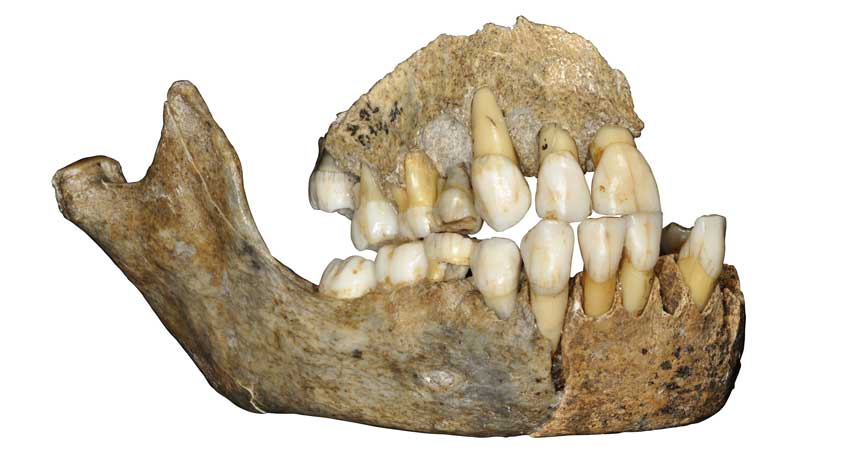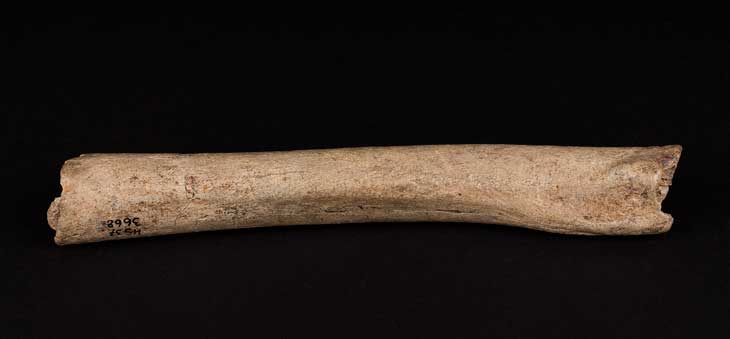
DEEP ROOTS Fossil jaws and teeth of a Neandertal child who lived around 120,000 years ago in what’s now Belgium provided DNA displaying close links to European Neandertals from 40,000 years ago.
J. Eloy/AWEM, © Archéologie andennaise
Neandertals had evolutionary stamina. An unbroken genetic line of the jut-jawed, powerfully built human relatives inhabited Europe for at least 80,000 years until dying out around 40,000 years ago, scientists say.
DNA extracted from fossils of two roughly 120,000-year-old European Neandertals displays closer genetic links to 40,000-year-old European Neandertals than to a Siberian Neandertal who also lived around 120,000 years ago, say paleogeneticist Stéphane Peyrégne and colleagues. Later Neandertals in Europe and western Asia trace at least part of their ancestry back to Neandertals represented by the newly isolated DNA, the researchers conclude online June 26 in Science Advances.
Evidence of European Neandertals’ genetic endurance starting about 120,000 years ago “fits nicely in the fossil record,” says paleogeneticist Carles Lalueza-Fox of the Institute of Evolutionary Biology in Barcelona, who did not participate in the new study. Ages of several early European Neandertal fossils fall at or near 120,000 years ago, he says.
Until now, researchers had Neandertal fossils, but no DNA, from more than around 100,000 years ago, keeping genetic ties among early Neandertals a mystery. Peyrégne, of the Max Planck Institute for Evolutionary Anthropology in Leipzig, Germany, and his colleagues obtained the DNA from an adult Neandertal’s upper-leg bone unearthed in Germany’s Hohlenstein-Stadel Cave and from a Neandertal child’s upper jaw and teeth recovered in Belgium’s Scladina Cave.

The new findings help make sense of previous discoveries at Siberia’s Denisova Cave, Peyrégne says. Scientists knew that a 90,000-year-old individual from the cave who had one Neandertal parent and one Denisovan parent (SN: 9/15/18, p. 9) possessed closer genetic ties to later European Neandertals than to a 120,000-year-old Neandertal from the same Siberian site. Given the new findings, some European Neandertals must have migrated east and at least partly replaced Neandertals already living in Siberia between 120,000 and 90,000 years ago, Peyrégne suspects.
A 2017 study, based on mitochondrial DNA typically inherited from the mother, indicated that the Hohlenstein-Stadel individual belonged to a maternal lineage that had split from all other Neandertals around 270,000 years ago, before any members of the species had trekked to Siberia. The new investigation, using nuclear DNA inherited from both parents, finds that the ancient child still belonged to a single, long-lasting line of European Neandertals. The fossil child’s mitochondrial DNA differences could have been produced by interbreeding of its male Neandertal ancestors with females who were relatives of ancient humans, and thus had their own signature mitochondrial DNA makeup, Peyrégne says.
Those mitochondrial DNA differences might instead have been introduced by Neandertals who left Europe for the Near East to escape frigid temperatures between around 200,000 and 130,000 years before returning to Europe, Lalueza-Fox suggests. The travelers would have had time to evolve slightly different mitochondrial DNA patterns from those of fellow Neandertals who stayed put, so no interbreeding would have occurred.






